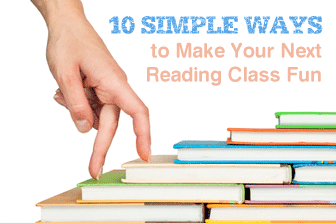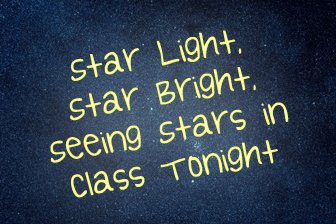10 Simple Ways to Make Reading Class Fun


We humans are fascinated by the gaseous wonders whose light may take years to travel from their places of origin to earth. Under the stars, some find significance, their places in the universe. Others feel overtaken by the vastness of space. Whether we feel large or small, close or distant, stars may be that spark you need to brighten up your ESL class. Try these activities based on the stars above us all and see your students improve their language skills down on earth.

If you were going to travel through the stars, what would you pack? It is an interesting question since life in space is so much different from life on earth. Have your students think about what possessions are most important to them, and then ask them to share with a partner what items they would bring into the outermost regions of the universe. Also, remind your students that as the speed of travel approaches the speed of light, time slows. This phenomenon has been portrayed in many popular movies. Ask your students to imagine what the world on earth would be like after they had travelled for one hundred years in space and they return to earth the same age as they are now! You may want to ask groups of students to create posters showing what the future of earth might be like when they return from their space travel.
For thousands of years, humankind has been seeing pictures in the stars. Though the pictures that ancient man saw are almost certainly different from those we see today, the stars have inspired humanity to see heavenly beings for years. Talk with your class about constellations, and see how much information your students already have about the stories in the skies. Can they identify any constellations? If so, do they know the names of those constellations? You may challenge their non-text reading abilities by providing diagrams of the night sky, both in summer and winter. Challenge your students to a scavenger hunt to find certain pictures or names of specific stars. Then use those constellations as a jumping off point to learn some of the mythology behind the beings we imagine up above. You can direct your students to read the mythology behind the constellations. To take the exercise a step further, ask each person to write a story featuring one of these mythological beings either in its constellation form or as its mythological character.
One of the most popular children’s poems is Star Light, Star Bright.
Star light, star bright
First star I see tonight
I wish I may, I wish I might
Have the wish I wish tonight.
Some children recite this poem every night as the first star becomes visible in the sky. Using this poem, you can do two different activities with your class. First, challenge each person to write his own poem about the stars. He should follow the same format and rhyme scheme as this poem though he should feel free to write about anything that has to do with the stars. Second, ask each person to think about what she would wish for if she said this poem to the evening’s first star. You may want each student to discuss her answer with a partner or have her write a short paragraph explaining what she would wish for and why. You can make a spectacular display on a classroom bulletin board to coordinate with the star theme. Take one or two strings of holiday lights and carefully staple them to a blank bulletin board, bulbs pointing out. (To do this, situate your staples so they fall on either side of the wire and do not puncture it.) Then, take dark blue or black paper and carefully cover the bulletin board. As you do, poke small holes in the paper for the light bulb to stick out. Then, when you are ready to light up your own night sky, plug the lights in and watch them twinkle in the darkness of night. If you like, allow your students to recite their poems in front of this display, and record their presentation. You can use this film later to review pronunciation during a one on one conference.
Another popular use of the word star comes in reference to celebrities in the entertainment world. The stars of Hollywood seem to change every day, but those who get their own star on the walk of fame will be remembered. Have your students imagine that they were each going to receive a star on the walk of fame. Ask each person to write an explanation of why he or she deserves the star and what accomplishments he or she has made to earn it. Of course, these will be fictional pieces, but your students should feel free to use their imaginations and dream big. If you like, give each person a star template to decorate and make your own walk of fame around the classroom. If you are lucky enough to live in the Los Angeles area, take a walk to the stars and do some rubbings of your favorites! Using a piece of paper large enough to cover the star, rub the side of a crayon over the engraving and see it replicated on your paper. If you like, display them in your classroom.
Your students will enjoy thinking, learning and writing about the stars in the sky when you invite them into your classroom.